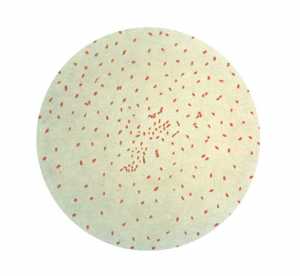05 Apr End of Honeymoon Period Means Whooping Cough Can Resurge
MedicalResearch.com Interview with:

This Gram-stained photomicrograph depicts numbers of Bordetella pertussis bacteria, which is the etiologic pathogen for pertussis, also known as whooping cough.
CDC image
Matthieu Domenech de Cellès PhD
Department of Ecology and Evolutionary Biology
University of Michigan, Ann Arbor, MI, USA.
Biostatistics, Biomathematics, Pharmacoepidemiology, and Infectious Diseases Unit
Institut Pasteur, Inserm,
University of Versailles St-Quentin-en-Yvelines,
Versailles, France.
MedicalResearch.com: What is the background for this study? What are the main findings?
Response: Our main motivation was to elucidate an apparent paradox: Why has the US experienced a resurgence of pertussis (whooping cough) since the mid-1970s, despite persistently high vaccine coverage? A variety of hypotheses have been proposed to explain this resurgence, but most attention has focused on the potential shortcomings of the new generation of pertussis vaccines (called acellular pertussis vaccines). However, there remains considerable uncertainty about the degree and the mechanisms of protection conferred by pertussis vaccines.
Via a collaboration with the local department of public health, we used detailed surveillance data in the state of Massachusetts to test a number of hypotheses about pertussis vaccines. We found that, although pertussis vaccines are imperfect (in the sense that they do not provide lifelong, 100% protection to 100% of children vaccinated), they are still highly efficacious. Specifically, we estimated that vaccine protection wanes over time, but slowly, with about 85% of children still protected 10 years after vaccination. Despite this high vaccine efficacy, we showed that the resurgence of pertussis was, in fact, to be expected. What happens is that the introduction of routine vaccination leads to an overall reduction in transmission, not only in vaccinated children but also in the population at large. Accordingly, those who escaped vaccination as children (as a consequence of incomplete vaccine coverage or imperfect vaccine protection) increasingly age having also avoided natural infection. As a result, the number of individuals susceptible to contract pertussis gradually increases. Because such people are the “fuel” of epidemics, this sets the stage for pertussis’ resurgence, with increasing incidence among older individuals.
This overall effect is called the “end-of-honeymoon” and means that resurgence is therefore a predictable consequence of incomplete vaccination with efficacious, but imperfect, vaccines. Importantly, these results show that recent trends do not necessarily reflect recent changes in the epidemiology of pertussis. Rather, they may be interpreted as a legacy of past immunization practices, with long-to-manifest effects. This is a significant shift of perspective about pertussis epidemiology.
MedicalResearch.com: What should readers take away from your report?
Response: Three key findings:
(i) The core transmission group is school-aged children, with little epidemiological impact of adults. Hence, our results suggest that schoolchildren should be the main target of vaccination campaigns, rather than the current emphasis on adults.
(ii) The acellular vaccines are highly efficacious.
(iii) Despite their effectiveness, control will need boosters because of the high transmissibility of pertussis.
MedicalResearch.com: What recommendations do you have for future research as a result of this work?
Response: Intriguingly, we found that the new generation of acellular vaccines conferred long-term protection against pertussis. This finding runs counter to a widespread view—derived from cohort-based studies—about these vaccines, and we are currently working on a new study to resolve these incongruities.
In addition, it would be useful to test our models to determine if the “end-of-honeymoon” effect explains the re-emergence of pertussis in other settings. For example, this hypothesis has already been proposed in England and Wales, but a systematic comparison across countries would help to shed light on the still enigmatic epidemiology of pertussis.
No disclosures
Citations:
Matthieu Domenech de Cellès, Felicia M. G. Magpantay, Aaron A. King, Pejman Rohani. The impact of past vaccination coverage and immunity on pertussis resurgence. Science Translational Medicine, 2018; 10 (434): eaaj1748 DOI: 10.1126/scitranslmed.aaj1748
[wysija_form id=”3″]
The information on MedicalResearch.com is provided for educational purposes only, and is in no way intended to diagnose, cure, or treat any medical or other condition. Always seek the advice of your physician or other qualified health and ask your doctor any questions you may have regarding a medical condition. In addition to all other limitations and disclaimers in this agreement, service provider and its third party providers disclaim any liability or loss in connection with the content provided on this website.
Last Updated on April 5, 2018 by Marie Benz MD FAAD
